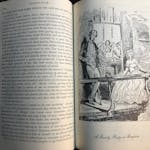Spring is the worst. I am perhaps the only person in Minnesota who thinks this way, but really, so much expectation all winter and then what? Brown grass and frozen nights for two months, brief greening, a little blooming before our first scorching days birth ravenous bugs, and then? Well, then it is summer, blessed summer. Something to love there, but not in spring. Except I am fond of the beginning of spring, the way the ice shifts with sounds of whales. Or when it breaks up, that one day when the lake sounds like Ojibwe ladies dancing in their jingle dresses. I love the maple snow — that wet and warm overnight weather that tells us it is time to tap, when sugarbush workers start the rush of boiling the tree sap around the clock.
And I do love the morning the wind shifts and the trees seem to embrace the breeze, move with it, bending and welcoming, instead of resisting and enduring as their bare arms have all winter. Of course, I love the million tiny birds twittering, blowing by in clouds even at night, migrating high and low from across the globe. Birds in spring insist we live — we will all live!
I am misleading you, I do not love the season. All the other seasons, I love. Summer comes with dramatic storms, intense sun, nights so thick you can lounge on the air, just lean back on it — it will hold you up. Fall has all the color and abundance that engendered feasts and festivals illustrated in textbooks. Winter is ideally frosty, white and dazzling. But what comes after — not even close to the classic floral backdrops from movies set in springtime.
Spring lacks drama here. We excel at the other three seasons though, so we can admit there's not much to see here between March and June. We've seen those fields with their gold stubble on black furrows before. We saw them just last fall in fact and they looked like they were settling into a nap, not hung over from a rough night. We've seen trees naked so long their bones show and still we wait months from red bud in last snow to full leaves in rain. It is excruciating. Tension, however, is not drama.
If we want spring drama, we have to drive north in late May and June when the light itself is tonic. It glows inside us at night and keeps us awake, restless, full of plans. A hike near Grand Portage is like entering another world of high cataracts churning with ice water and misting green shores where tiny wildflowers in complex designs bloom multicolored carpets. Fairy-tale fungi erupt there too on mysterious mossy mounds between tall and ancient trees.
Spring up north might make me love it — with its crust of snow on the shadow side of huge rocks and den of baby foxes sunning along the sandy shore below it. If you want to see the season glorified, go north. Spring lasts another month there. They say captives learn to love jailers, so maybe after another month, I'd love spring too.
Maybe and most likely, I am pitiful and human and so very childlike that I cannot understand what the world says with its growing light. Maybe I ignore lessons on patience and gratitude. Maybe if, through those brown months, I did not have to strain so hard to see the season in incremental change, I would not notice the minuscule flowers, the wee birds, the new red in the squirrel's fur, or the softer air around me.
Maybe, if I were not fed up with drab ditches and dead leaves I could not appreciate an overnight blanket of late snow that brightens up the place and makes a lovely music when it melts. You know, I always was too dense to know I was in love.
Heid E. Erdrich is a Loft-McKnight fellow in prose. A poet and nonfiction author, she is also editor of "New Poets of Native Nations," due out this summer from Graywolf Press. Erdrich is an enrolled member of the Turtle Mountain Band of Ojibwe. She teaches creative writing in the Augsburg University MFA program.




